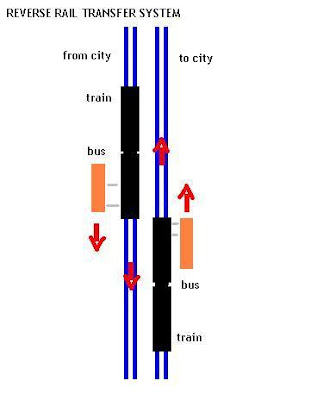This blog takes the view that while there exist ardent revheads, greenies, transit geeks and the lycra set, the majority of the population are pragmatists in their transport choices. Especially for habitual and often time-critical trips such as the journey to work.
So why isn't transit so attractive when you get much outside the Hoddle grid?
A play with the Metlink journey planner gives some answers.
Let's compare comparative travel times between similar distance middle-suburban stations and various CBD fringe workplaces. For arrival at a start time of 8:30am, the following results were had:
Laverton - Melbourne Town Hall: 33 min
Laverton - Melbourne University (Parkville): 40 min
Laverton - Epworth Hospital (Richmond): 49 min
Laverton - Alfred Hospital: 51 min
Laverton - South Melbourne Market: 45 min
Laverton - Citylink Business Park (Port Melbourne): 52 min
Laverton - Waterfront City (Docklands): 54 min
Greensborough - Melbourne Town Hall: 38 min
Greensborough - Melbourne University (Parkville): 60 min
Greensborough - Epworth Hospital (Richmond): 42 min
Greensborough - Alfred Hospital: 60 min
Greensborough - South Melbourne Market: 61 min
Greensborough - Citylink Business Park (Port Melbourne): 65 min
Greensborough - Waterfront City (Docklands): 67 min
Mitcham - Melbourne Town Hall: 40 min
Mitcham - Melbourne University (Parkville): 50 min
Mitcham - Epworth Hospital (Richmond): 43 min
Mitcham - Alfred Hospital: 47 min
Mitcham - South Melbourne Market: 52 min
Mitcham - Citylink Business Park (Port Melbourne): 50 min
Mitcham - Waterfront City (Docklands): 60 min
Cheltenham - Melbourne Town Hall: 32 min
Cheltenham - Melbourne University (Parkville): 50 min
Cheltenham - Epworth Hospital (Richmond): 43 min
Cheltenham - Alfred Hospital: 39 min
Cheltenham - South Melbourne Market: 53 min
Cheltenham - Citylink Business Park (Port Melbourne): 50 min
Cheltenham - Waterfront City (Docklands): 62 min
In every single case a trip to the CBD was faster than to a CBD fringe location.
This is even where the destination was on the same side of town as the origin (eg Cheltenham - Alfred Hospital). It could be for this type of trip that driving would be relatively more competitive than existing public transport services, and so command a higher modal share (people are pragmatic, remember). There may even be a self-reinforcing pattern; if people can't afford to buy a home in the inner suburbs near work they may choose an outer suburb on the same side of town as their work (if not always the same train line).
City fringe destinations vary in the amount of time they add compared to within Hoddle's grid.
Waterfront City is the least accessible by fast public transport - from any direction - despite its frequent trams. Compared to the CBD, travelling to it can add 20 to 30 minutes to travel time each way. For a commuter that's 40 to 60 minutes per day, or an extra week added to annual holidays. Not suprisingly its public transport modal share is just 22%, compared to double or triple that a little to the east.
Why are the variations in travel time so great?
We have an extensive suburban rail system that has metro-style operating hours but commuter-type frequencies on its fringes. We have trams, but unlike some compact European cities we don't have a dense metro in the job-dense 2-5km core (see maps by Neil Freeman) that allows for fast local travel. Instead for the 'last mile' we rely on slow surface modes, notably trams and buses, often without their own right of way.
Also the fixed rail we do have is planned and run as a suburban - CBD distributor rather than doubling as a (small) inner city metro that with its spare capacity could take pressure off trams for longer trips.
The City Loop's weekday noon reversal introduces unwelcome complexity, discourages casual travellers and prevents direct access between some city stations at certain times. Quite different from the consistency and legibility of a real metro.
For many years the possibility of getting a direct train from South Yarra to Footscray (for example) was scotched by the philosophy that everything should run via the Loop and the primacy of the CBD as a destination. The May 2011 timetable will introduce some welcome improvements for such cross-town trips, provided dwell times at CBD stations are kept down. Especially important as Flinders Street and Southern Cross are the nearest stations to Melbourne's fastest growing areas at Southbank and Docklands.
The May 2011 timetable will increase the number of trains that will run from Flinders Street through to Southern Cross. This ties in well with an important bus rerouting from last year, namely the restructuring of Port Melbourne routes (235/237/238) to operate via Southern Cross Station. This restored a rail-bus connection that vanished when the tram superstop in Flinders Street was built and buses were forced away from Flinders Street Station. Peak frequency of the Port Melbourne buses is high but further work would lift their legibility and profile.
Route 401, between North Melbourne and Mebourne University, is an example of a 'bridging the gap' frequent service that has become well accepted by those commuting from the western suburbs to Melbourne University. The trip plan above for Laverton include the 401 as its bus leg as it proved the fastest travel option. Other opportunities for 401-style service could include Melbourne University to Clifton Hill or South Yarra to Port Melbourne, although bus priority would assist in providing worthwhile savings in travel time and efficient vehicle utilisation.
It seems to me that the CBD fringe is an area ripe for future patronage growth. Unlike the CBD, where public transport modal share is near saturation, there is significant room here to grow. But this can only come about if it can get the pragmatists on board. To achieve it a fresh look at how the CBD fringe and the close job-rich inner suburbs can be better served may achieve some surprising patronage results, as demonstrated by the success of Route 401.

